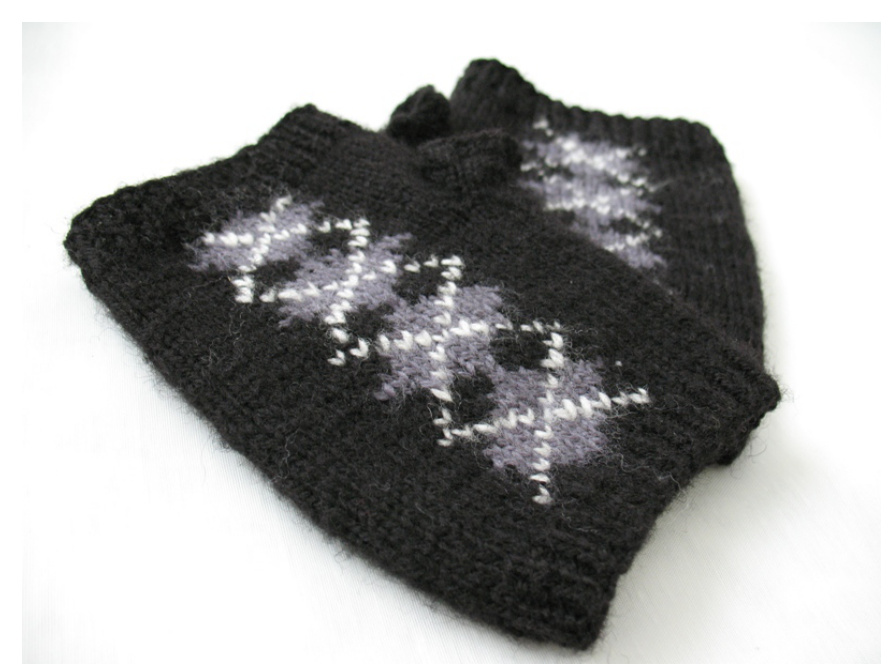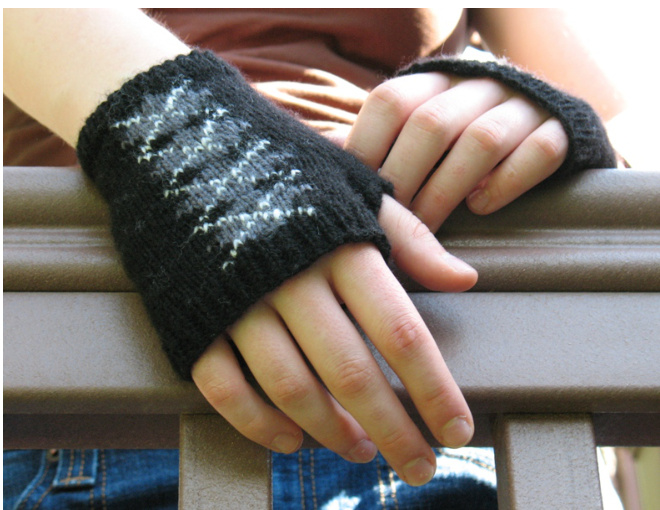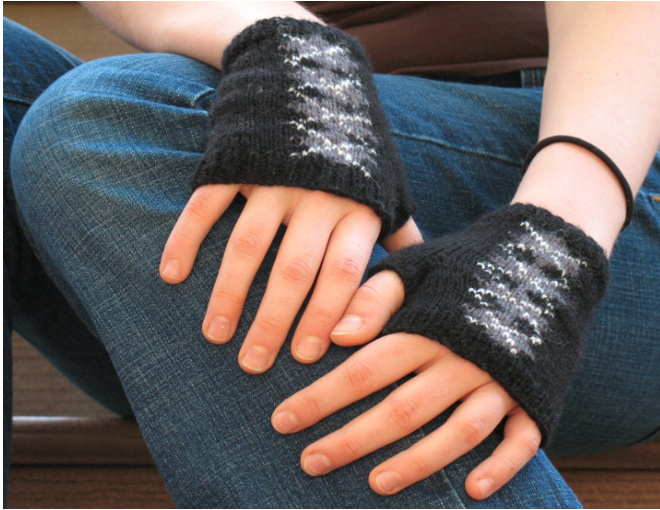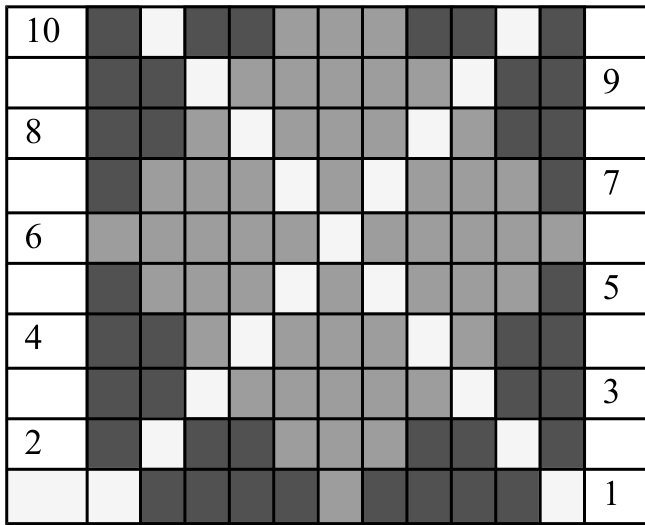Elv Argyle
$\mathcal{C}2008$ Please use this pattern for personal use only.

As I designed these fingerless mitts, I knew I wanted a simple design that incorporated argyle without the complications of an all-over argyle design; I think you'llfind the end result very easy and fun to knit. $\circledcirc$ Because of the simplicity of the design, it is easily adaptable to any hand size. Please note that though I've included approximations for various hand sizes, the only size I've knit is XS, for best results, be sure to measure the hand you are knitting for. I made the XS for someone with very small hands, so unless you are making these for a child or small teen, you will probably need the S size or larger. Also, be sure to check placement of the thumb gusset against each hand you're knitting to ensure that you can achieve a centered argyle chart. The gloves are worked flat with a 1 stitch garter selvedge for seaming. The seam will sit either on the edge of your hand or just inside your palm. If you'd prefer a stockinette seam, adjust for this as you knit the pattern. I've indicated how many stitches in I've placed the argyle chart to center it, but you can easily adapt this number depending on your preferred placement of the chart. The white “X's’ can either be knit in using the intarsia method or duplicate-stitched in. If you are using a dark colored yarn I'd recommend using the intarsia method. And, in case you're wondering; “Elva is a Gaelic name, meaning Scotland. Thus, Elva Argyle is a roundabout way of saying \*Scotland Argyle'. $\circledcirc$ If you find any errors or steps that need clarification please let me know.
Yarn: Knit Picks Palette
1 skein Black (MC) (I used about 100yds) 1 Skein Ash (CC) (I used about 10yds) 1 Skein White (WW) (I used about 4yds) Needles: Four Double Pointed Size 1 $(2.25\mathrm{mm})$ needles Gauge: (in stockinette stitch) 8sts per in and 12 rows per inch

Abbreviations:
$\mathrm{CO}{=}\mathrm{C}$ aston $k{=}\,\mathrm{knit}$ ${\mathfrak{p}}^{=}$ purlkfb $\risingdotseq$ Knit into front and back of one stitch Sizes: Measure around your knuckles (not including your thumb) to achieve the correct measurement, noting that you will want to avoid negative ease. Please remember the sizes are approximate as I have only knit the XS size. Women's XS $\left(6.5^{\circ}\right)$ cir), S $(7.5^{\circ}$ cir), M, $(8.0^{\circ}$ cir) L (8.5 cir)
Pattern:
Left Hand Mitt
Using the long tail cast on: C0 56 (62) (68) (74) sts with MC Row 1-6: K1 $\ast_{\mathrm{K1}}\,\mathrm{P1^{\ast}}$ repeat from \*to\* across (this rib pattern willcreate a garter selvedge, you'll need to adapt this to create a stockinette selvedge) NOTE: Sizes M and L may wish to work an additional 2-4 rows ofribbing before beginning argyle chart.
Row 7:
Knit 30 (33) (36) (39) sts (including the est. selvedge sts), and work row 1 of argyle chart NOTE: If you wish to create a garter selvedge, continue knitting the first and last sts of each row (as est. in ribbing) As you work the remaining argyle rows and repeats, simply “read your knitting” and use the stitches from the previous row to determine where your next stitches go. Be sure to consult the chart to ensure the correct pattern. I found it much easier to knit this way (especially when working in intarsia). Complete two full repeats of the argyle chart. Work rows 1-8 of chart (this will be your third repeat).

Thumb Gusset
On row 9 of argyle chart, knit 15 (18) (21) (24) sts, knit next 7 (8) (9) (9) sts onto waste yarn, slip sts that were knit onto waste yarn back to left hand needle and knit again using working yarn. Cont. argyle pattern until completion of fourth repeat Work Row 1 of argyle chart to complete final repeat. Purl one row using BB to prepare for rib. Work 6 rows of K1 P1 rib as est. (see beginning of pattern). Cast off loosely in rib pattern.
Thumb
Remove the waste yarn used for the thumb gusset, carefully placing resulting live sts on two double-point needles; there will be 7 (8) (9) (9) sts below the opening and 6 (7) (8) (8) sts above. Attach yarn BB and k the 7 sts on lower needle; using a second needle, pick up and $\mathtt{k}\,2$ sts in space between upper and lower needle, k first 3 sts from upper needle; using a third needle, k remaining 3 (4) (5) (5) sts from upper needle and pick up and $\textrm{k}2$ sts in space between this needle and lower needle. 17 (19) (21) (21) sts Knit 5 rounds, kfb in 1 st on last round. Knit two rounds in k1 p1 rib Cast Off in Rib
Right Hand Mitt
Work as for Left Hand Mitt, noting the exceptions that follow below:
Argyle Chart Placement
Row 7: Knit 15 (18)(21) (24) sts (including the est. selvedge sts), and work row 1 of argyle chart. Cont. in the manner noted for Left Hand mitt
Thumb Gusset
On row 9, knit 34 (37) (40) (43) sts (being sure to cont. argyle patt. as est.), knit next 7 (8) (9) (9) sts onto waste yarn, slip sts that were knit onto waste yarn back to left hand needle and knit again using working yarn.
Finishing
Weave ends in. Block piecelightly. If you chose to work the argyle chart without the “X's"' duplicate stitch them in using WW. Block piece again (if you used duplicate stitching). Seam the edges together (using the garter stitch selvedge)
Argyle Chart:










